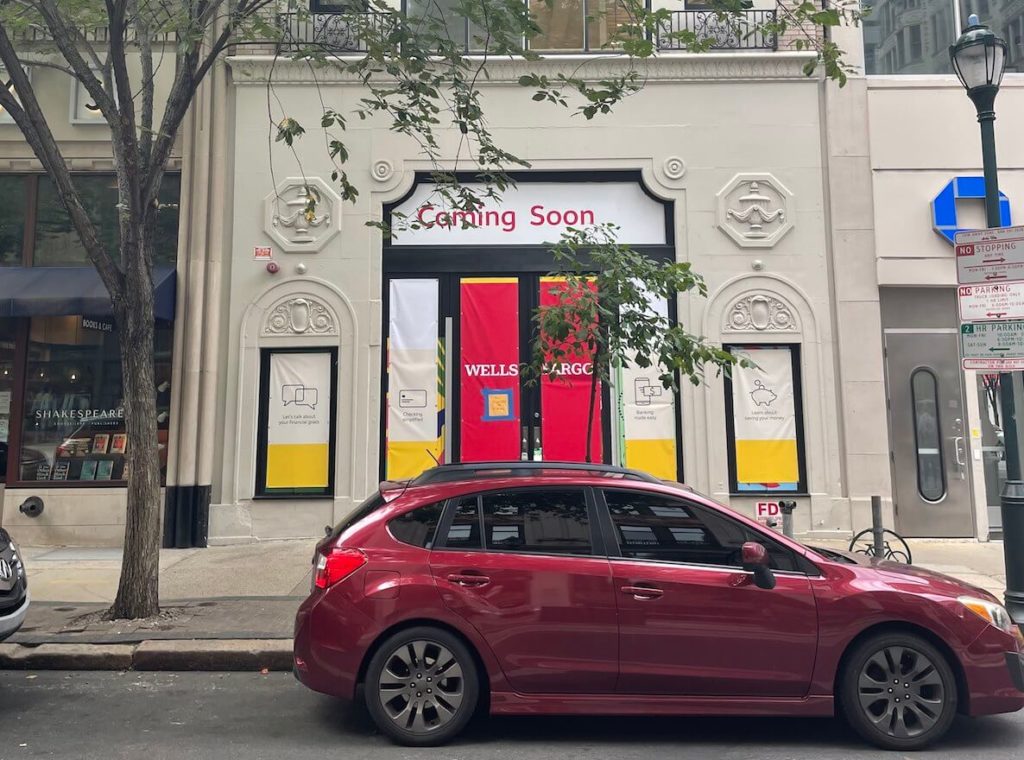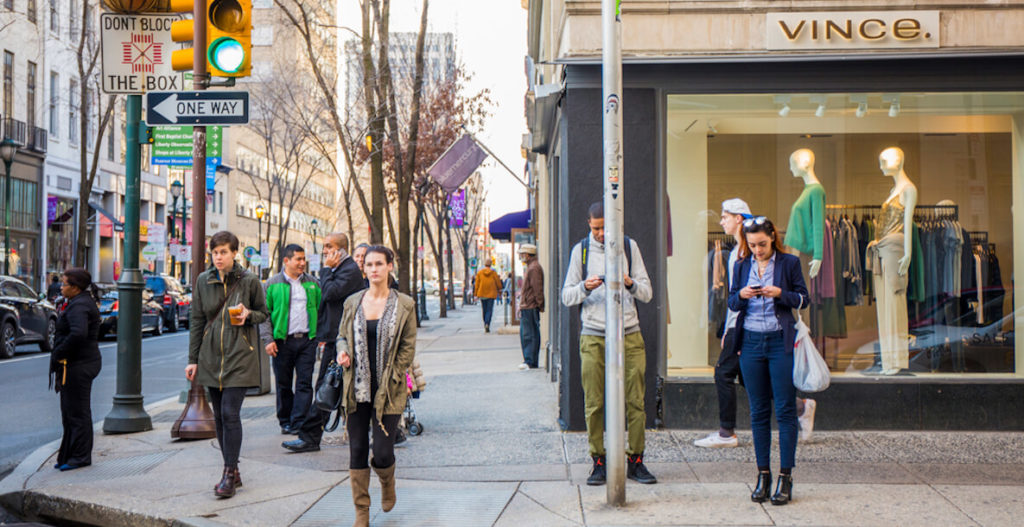For the last seven years, I have sat at the same café table. I have told myself that the corner tucked inside the Capitol One’s Pete’s Coffee concept is my productive place with its south-facing windows and gentle coffee grinder hum. In truth, I sit for the endless parade of four-legged passersby on the intersection of 17th and Walnut streets.
These days, there is no end to the doodle breeds—burma-doodles, golden doodles, muttadoodles, every poodle-mix imaginable. A good afternoon includes a lethargic shar-pei or grumpy bulldog. Occasionally, a dramatic and overheated corgi needs to be carried home. A great viewing afternoon is an endless tangle of leashes and exchange of human apologies as canines cross paths and sniff rear-ends.
What is lost when a block becomes less vibrant and interesting? Are there just less huskies crossing the street or is there a loss of connection from sidewalk encounters, that collectively and in time, work to be places of connection and even work to eliminate our bias?
However, the frequency of canine entanglement is changing as the corridor itself declines.
Even though there are far more dogs (the only good thing to come out of the pandemic) in the city than years’ past, fewer dogs cross the intersection. There’s no reason for human companions to cross over Walnut due to the high number of commercial vacancies and current use.
A large swath of Walnut was demolished after a fire last summer, while countless retailers, including Gap, Ulta Beauty, Talbots, Ann Taylor, and H&M, closed their doors following the pandemic. (Notably, a few high-end retailers like Barney’s and Intermix closed down before the pandemic.) In their absence, banks have become one of the main fixtures in the landscape. To date, three of four corners of the busy intersection have been assumed by banks. Another, Santander, is just a few doors down.

The Center City District provides pedestrian counts for high-trafficked intersections in the area. The most recent count from March shows that only 7,317 pedestrians trafficked this intersection. That is less than half (18,348) from March 2019, pre-Covid, and about 3,000 less than the count for September 2020 (10,052), right in the middle of it.
Recently bored with my reading and awaiting dogs to pass through the intersection, I was alarmed by advertisements for a Wells Fargo in the former location of Lucky Jeans. The changing intersection is an ominous warning of the monotonous city that awaits us if diversity of use is not prioritized.
The future of Center City West necessitates that Walnut Street remain interesting. That means lively streets that generate continuous foot traffic from a diversity of consistent and mixed uses—restaurants, Rittenhouse Square, professional and creative agencies, in addition to retail. These various uses keep a constant flow of pedestrian (and canine!) traffic on the sidewalk at all times and makes the street vibrant.
Like clockwork, by 9 each morning, early-morning business commuters are replaced by nannies and strollers. Around 10, late-morning yogis start making the return home with their mats. After a lull around 11, streets crowd with a sea of oxfords in every hue as professionals walk to lunch. Afternoons are filled with students and shoppers. Truly, the continuity of pedestrian movement is based on converging mixed uses.
As William Whyte, urban sociologist and author of City reminds us, “What attracts people most, it would appear, is other people.” While the Center City District’s pedestrian counts do not differentiate between the direction of pedestrian traffic (north/south versus east/west), it is clear that fewer individuals are crossing Walnut. Instead of zig-zagging down the corridor on Rufus’ walk to pick up coffee, yet another pair of sneakers (bad Rufus!), and a birthday gift for Rufus’ friend Jake, the Jack Russell, one simply walks through the commercial corridor to Rittenhouse Square.
There is no reason to cross the commercial corridor. Noted urbanist and author of The Life and Death of the Great American City, Jane Jacobs, points out that urban spaces can deteriorate as they lose their sources of vibrancy: “Whichever one of few uses have emerged as the most profitable in the locality will be repeated and repeated, crowding out and overwhelming less profitable forms of use”.
Understanding diversity in terms of physical use and purpose, interesting places, like Walnut Street, cease to be a draw when dull and monotonous establishments—in this case banks—hoping to capitalize on foot traffic, colonize the space and push out the original sources of diversity and attraction. It is why only Vince remains as a retail spot on the northwest corner of the intersection. Without retail and its resulting foot traffic, the corridor is no longer a destination of interest unto itself. Instead, it exists as merely a thoroughfare.
While a staunch urbanist would argue that many of the chain stores point to already existing homogeneous landscape, many, including Lululemon, Athleta, and Warby Parker, function as sources of vibrancy since there are no other commercial locations in the city. We do not have multiple commercial corridors like Fifth Avenue, Madison Street, or Canal Street like New York City.
Certainly I am not the only woman who remembers leaving Rittenhouse Square each evening by 9? Like the game of Jenga, city uses are interdependent. Pull out one piece and the whole structure totters.
Though one could argue that nearby amenities such as Rittenhouse Square and the quantity of downtown residences will keep the area vibrant, a quick trip down memory lane is a reminder of the essentiality of retail and of the mundane future that could await the area if we only rely on highest and best use.
Remember what Center City was like when many storefronts were closed down following the financial recession only 10 short years ago? The vacancies on Walnut Street quickly spilled over to Chestnut Street as well. Not only was there an absence of retail, there was a loss of secondary establishments like fitness boutiques and salons that thrived on foot traffic. This converging foot traffic at all hours of the day made the area not only interesting but safe.
Certainly I am not the only woman who remembers leaving Rittenhouse Square each evening by 9? Like the game of Jenga, city uses are interdependent. Pull out one piece and the whole structure totters. Retail makes the area attractive to young creatives, which in turn attracts firms (à la Richard Florida), which in turn, makes the area prime for restaurant concepts like Parc and The Love which, in turn, generates more foot traffic at the park at night. In the end, it turns out that the park is only as effective as the diversity of its adjacent uses.
What is lost when a block becomes less vibrant and interesting? Are there just fewer huskies crossing the street or is there a loss of connection from sidewalk encounters, that collectively and in time, work to be places of connection and even work to eliminate our bias as Elijah Anderson describes in Cosmopolitan Canopy?
Center City West still has potential to be a vibrant place of connection. It is close to mass transit and major universities. It is surrounded by robust residential neighborhoods. During lunch hour, masked lawyers and real estate agents still scurry to pick up their Chipotle orders while Temple and Penn students pick up ’90s flannel-wares at Urban Outfitters’ flagship store. However, in order to sustain this social tapestry, we need to make interesting streets a priority and long-term goal for the area.
MORE ON COMMUNITY REVITALIZATION IN PHILADELPHIA
How can this be accomplished? First, there needs to be advocacy and awareness of the importance of the commercial area. When local leaders did not respond to the large-scale looting and vandalism of the commercial corridor last summer, it invariably signaled to the retail industry that commercial businesses were not safe in Philadelphia.
Second, encourage long-term planning for the area when prospecting tenants for vacant property, even if it means incremental growth. “[Nature’s systems] develop strength and resiliency,” points out StrongTowns, a think tank dedicated to creating financially resilient towns, “through a pattern of incremental growth and adaptation. This is true for a culture growing in a petri dish or a rainforest with its many different flora and fauna. The order of these systems emerge from many complex interactions and adaptations.” Beyond banks and, increasingly, cell phone companies, what will bring a longevity of interest to the area?
Let me be clear, I do not blame developers for the process of homogenization—it is extremely difficult to get commercial tenants in the wake of Covid. However, best use should consider longevity of the corridor as opposed to the efficiency of “highest and best use.”
Lastly, incentivize interest in the area with events beyond boozy Center City Sips—food truck nights, small business pop-ups, dog nights, taco nights, dog and tacos nights… the list goes on. We have to ask ourselves: what do we want downtown to be in 10 years… for our dogs?
Lydia Kulina-Washburn is an educator in Philadelphia, where she lives. Her writing explores the intersection between education and place-making and has been featured in StrongTowns and NextCity. When not writing, Lydia is often walking her goldendoodle. You can follow her here.
The Citizen welcomes guest commentary from community members who stipulate to the best of their ability that it is fact-based and non-defamatory.
RELATED

